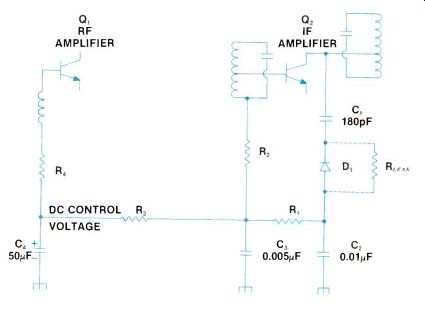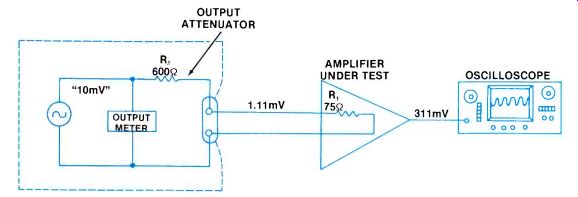By Joseph J. Carr, CET
An English gentleman left his office in London and went to his club for an evening of convivial fellowship with other gentlemen. When it came time to leave he went to the cloak room and found the porter standing there with his coat already in hand. The startled gentleman asked, "How did you know it was mine without the claim check?" The dignified porter retorted, "I didn't, sir. All I knew was that it's the coat you came in with...who owns it is another question entirely." That dignified gentleman's club porter refused to speculate on any fact not actually in evidence. That advice is good not just for cloakroom porters, but electronic servicers as well. Sometimes, the meters and oscilloscopes give us a bum steer and thereby lead us unprofitably astray. Let's take a look at several situations where the evidence of our senses and instruments gives us false results.
Case No. 1
A customer brought in an AM car radio. The complaint was that sometimes it whistled and sometimes it was distorted, but other times it played OK. The problem sounded at first like a classical intermittent-probably a loose connection or busted PC board. When the radio was turned on, the technician found that it worked and, in fact, on first blush appeared quite normal. He was about to assume it was just another NFF (no fault found), which happens quite often when customers work on their own sets without letting an expert check it out in the car.
But the technician was sharp, and he noted that the announcer tended to lisp a little on "S" and "P" sounds. Paying a little closer attention, he concluded that the lisping was due to the fact that the set was hyper-sensitive and was therefore on the verge of oscillation all the time.

Figure 1
The first place one might look in a radio with tunable oscillations (or lisping) is the automatic gain control (AGC) circuit. (See Figure 1.) The AGC samples the IF amplifier output signal, rectifies it and filters it to dc, and then uses the dc to control the gain of the IF and RF amplifier stages, so it forms a potential feedback loop if the decoupling is not working well. Hence, the AGC is always suspect in such cases.
Most AGC loops in AM radios contain a large-value electrolytic capacitor (C4) that filters the do control voltage, and if it is open oscillation will result. This capacitor is probably the classical cause of AGC oscillations. The technician bridged C4 with a known good capacitor, but it produced no change. He next suspected the power supply decoupling capacitors. Again, bridging a known good electrolytic capacitor of the proper value across the set's capacitors did no good at all. Next the tech pulled one end of AGC-rectified D, loose and measured both the forward and reverse resistances. The ratio was 5:1, and the "conventional wisdom" told him that diode was OK, so he soldered it back in. After a certain amount of head scratching and chin rubbing, he remembered that the customer claimed that the radio was sometimes distorted and at other times it was OK. Tapping the circuit board with an insulated probe didn't show any intermittents. Because the shop was too far from any AM station to receive a really strong signal, he connected the AM signal generator and tuned it to the radio dial frequency.
Sure enough, on strong AM signals (even though well within the normal permissible signal-strength range) the radio became distorted, while on weaker levels of RF input signal the distortion disappeared.
It was also found that the radio tended to oscillate a little as the dial was rocked on and off the signal generator frequency. On a hunch he replaced the AGC rectifier diode (D1), and the problem went away. The oscillation disappeared, the distortion disappeared, the announcer didn't lisp and the radio responded to the full dynamic range of input signals.
The root problem was leakage resistance across diode D1 (Rleak in Figure 1). The confusion was twofold. First, diodes are normally open or shorted; only rarely do they exhibit leakage or a partial short. Second, the "conventional wisdom" misled the technician. It seems that 5:1 (or even 10:1, the alternate conventional wisdom) is bum advice for high-impedance circuits. An order of 100:1 or even greater is more reasonable for real diodes in real AGC circuits.
Another confusion was that the technician was in a single location where signal strengths did not reach the levels required to drive the set into trouble. Installed in a car, however, the situation was different because the driver frequently had to drive close to the station. The same scenario could conceivably result on table-model or portable radios that play OK in the basement (where signal levels are small), but distort in the second-floor bedroom where signal levels are higher. It also shows that the technician should not depend on a quick or cursory check of any equipment; the problem might be subtle.
Case No. 2
Fresh from spending 15 minutes too long on Case No. 1, the same technician picked up another car radio and tossed it on the bench.
This model was an older, solid-state AM radio from the early 1970s. Turning it on, he found the same symptoms. "AHA!" he thought to himself, "Another bad AGC rectifier diode!" After replacing D1, he found the problem persisted. In this case, collector-to-base leakage in the RF amplifier transistor caused a symptom similar to the symptom in Case No. 1.
Although not a big problem today, it was common in the "olden days" when AM RF amplifier transistors were all germanium. (Note: The problem can exist on silicon transistors but it is a lot rarer than on Ge devices.)
Case No. 3
A Cable-TV/MATV maintenance repair installation organization (MRIO) had a technician who checked out equipment before giving it to field installers, and who also repaired defective equipment.

FIGURE
2
The technician was required to service both VHF/UHF channelized RF gear as well as baseband video amplifiers. Being frugal, the manager gave her a function generator to supplement the VHF/ UHF TV generator, with the idea that the 0.01Hz to 11MHz function generator could service the 100Hz to 6MHz video baseband equipment. The function generator was a bright, gleaming new model that produced square waves, sine waves, triangular waves and variable duty-cycle pulses. It was truly a quality piece of test equipment.
The technician set up the function generator to make gain checks on the baseband video amplifiers prior to issuing them to field people. These amplifiers were specified to 40dB voltage gain (X100) and could accept high-level inputs to 25mV without overloading. Knowing these specs, she set the signal generator output frequency to about 1MHz and dialed up an output level of 10mV rms (well within overload spec). A 40dB voltage amplifier has a gain of X100, so she expected an output of 10mV x 100, or 1,000mV (1V). Because her output indicator was an ac-coupled wideband oscilloscope, which reads peak-to-peak (p-p) voltage, she expected to see about 2.82 x 1,000mV, or 2,820mV on the CRT screen. Unfortunately, the reading was only slightly more than 300mV. It was obviously a defective amplifier, so she put it aside for repair later. Because the impatient field crew needed an amplifier, she grabbed another and checked its gain. It too had an output voltage around 300mVp-p.
Two new amplifiers in a row with the same symptoms? Unlikely, for the brand was good quality and had a long record of working properly. So, being a bright young lady from a good technical school, she figured that something was wrong with the test setup. She first looked at the function generator operator's manual, and there she found the difficulty.
Function generators, despite their wide frequency range, are designed like audio generators and thus have a 600 ohm output impedance. Furthermore, the output level meter is ahead of the stepped output attenuator that sets both the level and the constant 600 ohm output impedance. (See Figure 2.) As a result, the output level is accurate only when the signal generator output terminal is terminated in a 600 ohm impedance. The video amplifier, on the other hand, has a 75-ohm input impedance. In this circuit, the actual output voltage, V0, as opposed to the meter reading, is: Vo = (10mV) (R1)
(R1 + Rs)
Vo(10mV) (75)
(75 + 600) Vo = 750mV/675 = 1.11mV
As a result of an incorrectly specified signal generator, despite the fact that it worked on the right frequency, the good 40dB amplifiers output 1.11mV x 100 = 111mV, or 313mVp-p ... exactly what Brenda measured.
In past times, that type of error was unlikely because audio generators, with their 600 ohm output impedances, rarely worked above either 20kHz or 100kHz at the highest. But today the technology finds it easy to provide multi-waveform function generators with low-end frequencies in the sub-hertz range and high-end frequencies in ranges that were clearly "RF" a decade ago. One expects RF generators to have a 50 ohm output impedance unless specifically designed for TV/video applications, in which case it is 75 ohm...not 600 ohm!
Case No. 4
A building's cable system is designed around 75 ohm equipment, which is standard for TV/video systems. By error, an installer uses 5011 coaxial cable to wire a section of the building. When signal levels are measured, it is found that slight anomalies exist.
Some gains are too high, and others are too low. Can we find the answer to the mystery? Consider Figure 3.
Whenever an RF or video amplifier is mismatched as regards input and/or output impedances, a standing wave ratio (SWR) exists.
The SWR will cause a mismatch loss of:
ML =-10 LOG (SWR1)2 SWR + 1
For example, when the SWR is 2:1, the gain mismatch loss is about 0.51dB. If there are two SWRs working with or against each other, the multiple reflected and incident waves bounce around
the coax, adding and subtracting R1/Z = 75/50 = 1.5:1 to signal levels, and produce a R2/Z = 75/50 = 1.5:1 mismatch loss of:

FIGURE 3.
In the system of Figure 3, we have two SWRs involved:
In other words, we have a pair of 1.5:1 SWRs. When these SWRs are cranked through the formula, we have a pair of possible gain errors of + 0.34dB or 0.35dB. In other words, a 10dB gain amplifier might ordinarily measure either 10.34dB or 9.65dB. While this variation might seem inconsequential (there are places where it is not!), it serves to illustrate a problem that becomes much worse with a larger mismatch.
Not everything is as it seems, a fact that points up the necessity for the technician to be more than a potted plant at the back of the shop. Some technicians I have known over the years always want a "cookbook" service guide that says, "When you see this, replace (or do) that." In real life it sometimes pays to think.
Also see: